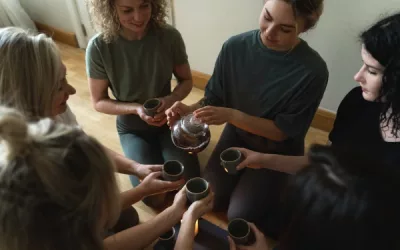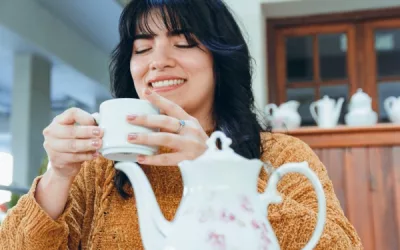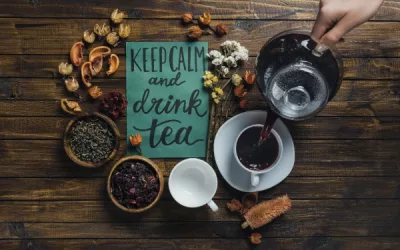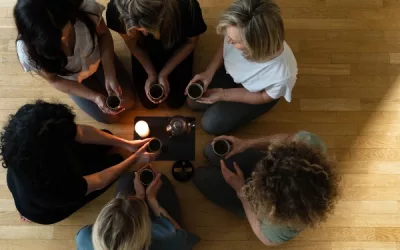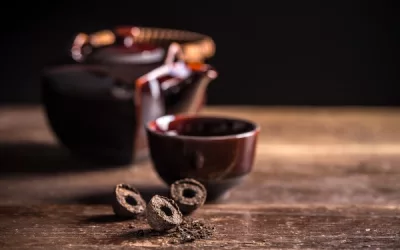Did you know that tea time, a beloved British tradition, has its roots in 19th-century aristocratic society? This cherished ritual has not only sparked a cultural phenomenon but also shaped social connections across the UK and Ireland. Understanding tea time is essential, whether you’re a history buff or a foodie, as it reflects deeper values of hospitality and community. This guide will explore the rich history, regional customs, traditional foods, and the etiquette surrounding tea time, allowing you to savour every sip and bite in true style.
Table of Content
- What is the history of tea time?
- How do tea time practices vary across the UK and Ireland?
- What is the etiquette for hosting a traditional tea time?
- How can one recreate an authentic tea time experience at home?
- What are some common misconceptions about tea time?
- How has tea time been represented in literature and film?
- What are the benefits of participating in tea time?
- Conclusion
What is the history of tea time?
Tea time has a rich and fascinating history that dates back to the late 18th century. This delightful tradition has evolved, becoming an integral part of British culture. Anna, the Duchess of Bedford, is often credited with popularising this custom. During the late 18th century, she introduced the idea of an afternoon tea to quell the hunger she would experience between lunch and dinner. The duchess would invite friends to join her, and soon, the practice caught on within aristocratic circles.
As years went by, tea time transformed from a private, social gathering into a widespread cultural tradition. The cultural significance of tea time cannot be overstated. It’s a moment of relaxation, socialisation, and indulgence. Today, tea time can vary regionally, with some areas favouring cream teas (scones with clotted cream and jam) and others offering a more elaborate spread. This tradition has transcended social status, welcoming everyone from royals to commoners. Historical anecdotes abound, illustrating how integral this ritual has become to British identity.
Who popularised the tradition of tea time?
Anna, the Duchess of Bedford, popularised tea time. She found that she would get peckish during the long gap between lunch and dinner and started requesting a tray of tea, bread, and butter to be brought to her room. She began inviting friends to join her, formalising the event. Soon after, high society followed suit, and tea time became a fashionable afternoon activity.
Some key details about Anna, the Duchess of Bedford:
- Lived during the late 18th century
- Played a pivotal role in establishing the afternoon tea tradition
- Known for her social gatherings
- Part of the British aristocracy
It’s fascinating to think how one person’s lifestyle innovation could shape an enduring cultural practice enjoyed by millions today.
How has tea time evolved over the years?
Tea time has undergone many changes since Anna’s day. Originally, it was a private, intimate setting but gradually grew into a social event full of pomp and circumstance. Over time, tea time began to include a wider variety of foods and social contexts. It moved beyond private homes and into cafés, hotels, and restaurants.
Here’s a breakdown of how tea time has evolved over the years:
- 18th Century: Began as a private social gathering among the aristocracy.
- 19th Century: Became popular in middle and working-class homes.
- Early 20th Century: Found its place in public venues like cafés and tearooms.
- Modern Day: Now a celebrated cultural experience, available in different forms and settings.
Despite these changes, the essence of tea time—a moment to unwind and enjoy good company—remains constant. Today, tea rooms across Britain and even internationally uphold this cherished tradition.
What role does tea time play in British culture?
Tea time holds a central place in British culture. It’s more than just a meal or a break; it’s a unique cultural ritual that brings people together. It serves as a pause in the busy day, allowing for an interval of connection and comfort.
Key roles that tea time plays in British culture:
- Social Tradition: Encourages face-to-face interactions and strengthens social bonds.
- Culinary Experience: Offers a variety of treats like scones, finger sandwiches, and pastries.
- Cultural Identity: Represents a quintessential aspect of British heritage.
- Relaxation: Provides a well-earned break in the day, promoting mental well-being.
From family gatherings to formal occasions, tea time adapts to different social settings, making it a versatile and enduring tradition.
In the early 20th century, King George V took tea time seriously. He even had a special bread that was baked specifically for tea time at Buckingham Palace. The royal touch certainly helped maintain the elegance and significance of the tradition. During World War II, tea time served as a morale booster for citizens, offering a comforting semblance of normalcy amidst the chaos.
How do tea time practices vary across the UK and Ireland?
Tea time practices in the UK and Ireland are a cherished tradition, though they have distinct regional variations that reflect local culture and history. From England’s elegant afternoon tea to Ireland’s hearty servings, each region boasts unique customs, food, and timings.
Tea time isn’t just about sipping a hot beverage; it’s an experience. Each area in the UK and Ireland has a unique way of embracing this tradition. Below, we’ll dive into the different practices, starting with a detailed comparison of each region.
Comparison Table of Tea Time Practices
| Region | Customs | Food | Timings |
|---|---|---|---|
| England | Elegant afternoon tea, often in hotels or tearooms | Finger sandwiches, scones, pastries | 4:00 PM – 6:00 PM |
| Scotland | High tea, a more substantial meal | Savouries, pies, cakes | 5:00 PM – 7:00 PM |
| Wales | Rustic and community-focused | Bara brith, Welsh cakes, sandwiches | 3:30 PM – 5:00 PM |
| Northern Ireland | Casual gatherings at home | Soda bread, potato farls, sweet treats | 4:00 PM – 5:30 PM |
| Republic of Ireland | Home-oriented, laid-back | Scones, brown bread, sweet bakery items | 4:00 PM – 5:00 PM |
| Cornwall | Cream tea, focusing on local produce | Scones with clotted cream and jam | 3:00 PM – 5:00 PM |
| Devon | Cream tea, strong community aspect | Scones with clotted cream, jam; often with a side of sandwiches | 3:30 PM – 5:00 PM |
Each region’s unique approach to tea time reflects its local customs and the people’s preferences. Let’s dive deeper into some of these regions to understand their tea time practices in more detail.
England
In England, afternoon tea is a sophisticated affair, often held in posh hotels or charming tearooms. The experience is elegantly crafted, complete with tiered stands filled with delicate treats.
- Finger sandwiches with fillings such as cucumber, smoked salmon, and egg mayonnaise.
- Scones served with clotted cream and jam.
- Assorted pastries and cakes, such as Victoria sponge or éclairs.
- A selection of teas, sometimes including champagne for a special touch.
England’s afternoon tea usually starts around 4:00 PM and can stretch until 6:00 PM. Whether it’s a leisurely weekend activity or a fancy treat for visitors, it remains a beloved tradition.
Scotland
High tea in Scotland is a substantial meal often enjoyed after a day of work. This tradition melds the simplicity of tea with the heartiness of dinner.
- Savoury items like sausage rolls, fish, and various pies.
- Hearty cakes such as Dundee cake or shortbread.
- Often accompanied by a pot of strong black tea.
This meal takes place between 5:00 PM and 7:00 PM, providing both sustenance and comfort after a long day.
The UK and Ireland’s tea time practices have deep historical roots. For instance, during World War II, tea time became a morale booster. The tea symbolised comfort and continuity amid hardship. In many homes, people gathered over tea to share stories and support each other.
Growing up, I remember my gran’s tea-time ritual in a quaint Welsh village. The tea table was set with delicate porcelain, and the aroma of freshly baked bara brith filled the room. We’d gather around and the time seemed to slow down as we shared stories, laughter, and, of course, delicious treats. This blend of tea and togetherness made those moments truly special.
What traditional foods are served during tea time?
Let’s jump right into it – tea time is the sacred hour (or two) in the afternoon when Brits and the Irish have their tea along with a selection of scrumptious bites. We’re talking about layers upon layers of tradition here, so let’s see what’s on the table.
Tea time is like a tiny banquet that perfectly balances sweet and savoury. You’ll often find crustless sandwiches, buttery scones, and a variety of cakes and pastries. Every bite has its own story and cultural lure.
What are the most popular foods served at tea time?
Let’s spill the tea on popular tea time foods. First up, sandwiches, but we’re not talking ham slapped between two slices of bread.
- Tea sandwiches: Little, crustless wonders filled with cucumber, smoked salmon, egg and cress. They’re cut into dainty rectangles or triangles that scream sophistication.
- Scones: Flaky delights often served with clotted cream and jam. They might look simple, but they’re a taste bud explosion.
- Victoria Sponge: Named after Queen Victoria, this cake is all about layers of sponge, jam, and whipped cream, dusted with powdered sugar.
- Pastries and tarts: Think mini éclairs, fruit tarts, and macarons. Each bite is a journey into a world where butter reigns supreme.
- Biscuits and cookies: Digestives, shortbread, and ginger nuts. Ideal for dunking, these biscuits are the unsung heroes of tea time.
How are scones traditionally prepared?
Let’s get to the bottom of the scone mystery. It’s all about the flakiness and that melt-in-the-mouth texture.
- Ingredients: The holy trinity of flour, butter, and milk. Some may throw in sugar and a touch of salt.
- Preparation: Mix dry ingredients, then rub in cold butter until the mixture looks like breadcrumbs. Stir in milk until it forms a dough.
- Kneading: Lightly knead the dough (don’t overdo it, or you’ll end up with tough scones).
- Cutting: Roll out the dough (not too thin) and cut into rounds using a cutter.
- Baking: Pop those rounds into a hot oven until they’re golden and risen. Serve them warm, preferably.
What types of sandwiches are typically included?
Now, onto sandwiches – the understated stars of tea time. These aren’t your average sandwiches; they’re works of art.
- Cucumber sandwiches: Thin cucumber slices on lightly buttered bread. Elegant and refreshing.
- Smoked salmon: Smoked salmon with a touch of cream cheese or butter. Sometimes garnished with dill or capers for that extra zing.
- Egg and cress: A mixture of hard-boiled eggs, mayonnaise, and cress. Simple yet oh-so-satisfying.
- Chicken salad: Shredded chicken mixed with mayonnaise, sometimes lightened up with a touch of celery or grapes.
- Ham and mustard: Thinly sliced ham with a smear of tangy mustard. A perfect marriage of flavours.
The joy of tea time sandwiches lies in their simplicity and the quality of their ingredients. Fresh bread, high-quality fillings, and the right cut make all the difference.
Once upon a time, in the land of London during the 1840s, Anna, the 7th Duchess of Bedford, found herself growing peckish around four in the afternoon. With dinner at 8 pm, she couldn’t stand the mid-afternoon hunger pangs.
So, she requested tea, bread, and butter to tide her over. This modest snack quickly transformed into a fashionable social event, where Anna invited friends over for small bites and chit-chat. Thus, the delightful tradition of afternoon tea was born, steeped (pun intended) in aristocratic charm and style.
So, next time you munch on a sandwich or nibble a scone, remember you’re partaking in a tradition that even queens embraced!

What is the etiquette for hosting a traditional tea time?
When it comes to hosting a traditional tea time, think of it as blending the finesse of a Michelin-star chef with the grace of a royal ballroom dancer. It’s about more than just pouring hot water over a bag of dried leaves. We’re talking tea-time, a British institution packed with tradition, elegance, and a dollop of snobbery—for good measure.
To host a tea time that would make even the Queen proud, you’ve got to know the etiquette. This involves fine china, crisp linen, and conversations as smooth as your Earl Grey. Allow me to spill the tea (pun absolutely intended) on nailing this age-old tradition.
What are the key elements of tea time etiquette?
Imagine you’re hosting Downton Abbey. You’d need a few key elements to keep the standards high—without hiring a full staff.
- Fine China: No chipped mugs or those cheeky “#1 Dad” cups. Bring out the porcelain teacups with delicate floral patterns. The fancier, the better.
- Linen Napkins: We’re not wiping mouths with paper napkins here. Crisp, white linen is a must.
- Seating Arrangements: Guests should be comfortably seated; usually, this means a well-set dining table or a cosy parlour. Keep things balanced but informal.
- Serving Order: Pour the tea before you serve anything else. Always ask, “milk or sugar?” or else face the social guillotine.
- Dress Code: No pyjamas, thanks. Aim for smart-casual or go all out with semi-formal attire. Think Downton, but not the servants’ quarters.
- Polite Conversation: Topics should be light and cheerful—weather, books, maybe the latest royal scandal. No politics or religion unless you’re keen on uncomfortable silences.
When done right, tea time feels like a gentle waltz through British culture. Miss a step, and it’s more like a sad cha-cha. No one wants to be remembered as the host who served Darjeeling in a sports mug.
How should guests behave during tea time?
Picture this: You walk into a room and everyone’s staring at you because you dunked your biscuit like it was the Titanic. Avoid becoming a tea-time pariah by following some basic guest etiquette.
- Punctuality: Arrive on time. Fashionably late is only fashionable at cocktail parties.
- Polite Conversation: Stick to light, pleasant topics. Keep your political hot takes for Twitter.
- Napkin Usage: Place it on your lap, not your collar. You’re not about to get a shave.
- Handling Teacups: Hold the cup by the handle; if you hold the body, you might as well be at a truck stop diner.
- Sipping Tea: Softly and elegantly, no slurping. You’re not a dog at a water bowl.
- Acceptable Nibbles: Never, ever dunk biscuits (or scones, the horror!) into your tea. This is not a pub.
Common mistakes include talking loudly, monopolising the conversation, and—heaven forbid—checking your phone. If you follow these guidelines, you’ll blend in seamlessly with the tea-time elite and not stick out like a sore, uncultured thumb.
What is the significance of using fine china?
You might wonder why you can’t just use any old cup to sip your precious Darjeeling. Using fine china isn’t just about showing off (though that’s part of it); it serves several purposes.
- Heat Retention: Porcelain keeps your tea hotter for longer without burning your hands.
- Delicate Appearance: Adds an element of sophistication and grace.
- Historical Significance: Reflects centuries of tradition and culture.
- Flavour Preservation: Ensures the tea’s subtle flavours aren’t overshadowed by inconsistent heat.
- Aesthetic Appeal: Looks darn good on Instagram, let’s be honest.
Fine china is like the elegant grandmother who always brings class to family gatherings. It’s there not only to show off but to elevate the entire experience.
Hosting a tea time without fine china is like showing up to a black-tie event in flip-flops. Sure, it’s functional, but you’ll get some serious side-eye.
Trace back to the 1800s, when Anna, the Duchess of Bedford, supposedly popularised afternoon tea. She found herself peckish between lunch and dinner (dinner was late back then, apparently), so she ordered tea, bread, butter, and cakes to stave off hunger.
Word spread, and soon the British aristocracy were sipping their Earl Grey from delicate porcelain cups. Who knew a bit of mid-afternoon hunger could start such a delightful tradition?
How can one recreate an authentic tea time experience at home?
Recreating an authentic tea time experience at home isn’t as complicated as building a spaceship. But it does require some planning, a little bit of effort, and a dash of sophistication. Ready to dive into the land of scones and fine china? Right, let’s get brewing!
So, you’re looking to recreate that quintessential tea time all the Britons brag about? It’s all about nailing the details. Think of it like throwing a mini party, but fancier, with a touch of historical elegance—like Downton Abbey, minus the butlers and drama.
First things first, you need to master the menu. The tea time menu isn’t just about tea – oh no! It’s a carefully orchestrated dance of sweet and savoury items that’ll make your taste buds do the cha-cha.
- Finger Sandwiches: Think cucumber, smoked salmon, egg mayo – sliced into dainty rectangles or triangles.
- Scones: These are non-negotiable. Serve with clotted cream and a selection of jams or conserve.
- Pastries: A mix of mini cakes, eclairs, and other delicate pastries.
- Biscuits and Shortbreads: For those who love things crispy and crumbly.
- Depayments: Macaroons, anyone? A bit of French flair can’t hurt.
- Fruit: Some sliced strawberries or grapes for a touch of freshness.
These items are the heart of a tea time menu, striking the perfect balance between light snacks and indulgent treats.
How can I create a suitable atmosphere for tea time?
Creating the right atmosphere is crucial. It’s the secret ingredient that’ll transport your guests to a quaint English tearoom, without leaving your living room.
- Table Setting: First, grab your best tablecloth – lacy if you’ve got it. Set out your finest china, because tea time is no time for IKEA plates.
- Teapot and Cups: A proper teapot with matching cups and saucers; bonus points if they’re floral.
- Cutlery: Forks, knives, and teaspoons – all sterling silver, if you’ve got them, or at least pretending to be.
- Flower Arrangement: Toss in some fresh flowers (roses or daffodils) in a petite vase – your table’s centrepiece.
- Music: Soft classical music, or perhaps some vintage jazz. Alexa, cue the ambiance!
- Lighting: Keep it cosy with natural light or a few candles for that evening glow.
The atmosphere sets the stage, ensuring your guests feel like they’ve stepped into a Victorian novel.
What types of tea are best for tea time?
Choosing the right tea is like casting a spell; it sets the mood and character of your gathering. You can’t just throw in any old bag and call it a day.
- Black Tea: Classics like Earl Grey or English Breakfast. Strong, bold, and quintessentially British.
- Green Tea: For a lighter taste – think Gunpowder Green or Jasmine.
- Herbal Tea: Chamomile or Mint for those who avoid caffeine.
- White Tea: Delicate and slightly sweet; a bit posh, really.
- Oolong Tea: The middle ground between green and black – for the undecided.
Having a diverse selection ensures there’s something for everyone, from the hard-core tea enthusiasts to the casual sippers.
Now you’ve got the tools to host an authentic tea time that’ll make even the Queen nod in approval.
During the 19th century, Anna, the Duchess of Bedford, complained of a “sinking feeling” in the late afternoon. Back then, it was common to have only two meals a day: breakfast and dinner. To stave off her hunger, Anna started asking for a tray of tea, bread, butter, and cake around 4 pm. Soon, she began inviting friends to join her – turning tea time into a fashionable social event.
This trend spread like wildfire, and before long, the high society of England embraced tea time as an established tradition. So, the next time you’re sipping your Earl Grey and munching on a scone, give a little nod to Anna. Without her, tea time wouldn’t be the charming ritual we cherish today!
What are some common misconceptions about tea time?
You’ve got people mispronouncing ‘scone’ and thinking ‘High Tea’ is fancy, so it’s high time we debunk some tea time misconceptions. Now, let’s get into the nitty-gritty of those cultural stereotypes, misconceptions about food, and the evolution of tea time. Fancy a cuppa?
What are some myths about tea time?
There are more myths swirling around tea time than there are varieties of tea – and trust me, that’s saying something:
- Exclusively Upper Class: Some folks picture tea time as an elitist gathering of lords and ladies, perched on gilded chairs, sipping daintily from bone china. Reality check – everyone enjoys a good tea break, from school kids to office workers.
- Always High Tea: High Tea is often thought of as some posh event. Actually, it’s more like a hearty working-class meal with meat, bread, and plenty of tea. Afternoon Tea, with those delicate sandwiches and pastries, is what you’re trying to think of.
- Always the Same Everywhere: Nope. Regional variations are a big thing. In Cornish tea, the cream goes on top of the jam, while in Devon, it’s the other way around. It’s a matter of serious debate, I tell ya!
- Just Tea and Biscuits: If you think tea time is all about a biscuit, you’re missing out. Think finger sandwiches, scones with clotted cream, pastries, and yes, the obligatory cuppa.
- Monumental Ceremony: Some believe every tea time is an elaborate event with rules galore. Sometimes, it’s just a quick break with a mug and a slice of cake.
Debunking these myths not only broadens our understanding but also makes us appreciate the rich tapestry of tea time traditions.
How has tea time changed over the years?
Tea time isn’t stuck in a Victorian time warp. It has evolved, like your wardrobe from the ’80s:
- From Elite to Everyday: Initially a highbrow affair, tea has trickled down through the ranks. Nowadays, everyone enjoys a cuppa.
- Commercialisation: Tea rooms and hotels have added their twist. ‘Cream teas’ and ‘Afternoon Teas’ at swanky places have turned it into a commercial delight.
- Global Influence: The British Empire spread tea plants and traditions around the world, influencing and getting influenced by other cultures. Hello, Chai!
- Health Craze: With a spotlight on wellness, many now sip herbal teas and green teas instead of the classic black tea with milk and two sugars.
- Modern Takes: From themed afternoon teas to pairing with cocktails and teas infused with exotic spices, tea time is continually being reimagined.
Evolution has only enriched the tradition, making it adaptable and relevant through the ages.
Is tea time only a British tradition?
Contrary to popular belief, the Brits don’t hold a monopoly on tea time. Here’s how it rolls around the world:
- Japan: The Japanese tea ceremony, or ‘Chanoyu’, is a highly ritualised event focusing on aesthetics, mindfulness, and precision.
- China: With its heritage of tea houses and diverse tea types like oolong and pu-erh, China treats tea time with both casual enjoyment and ceremonial reverence.
- India: Often termed ‘Chai time’, India’s tea tradition includes additives like spices (yep, Masala Chai), milk, and sugar, creating a flavour explosion.
- Russia: Known for its Samovar, Russians enjoy Zavarka, a tea concentrate, and mix it with hot water, often accompanied by sweet or savoury snacks.
- Turkey: Turkish tea, or ‘çay’, is served in tulip-shaped glasses, often strong and sweet. Social, warm, and ubiquitous.
- Morocco: Mint tea is a staple, prepared with green tea, fresh mint, and loads of sugar. A big part of their hospitality.
Tea time isn’t just a British pastime but an international one, shaped by various beliefs and customs. Each culture adds its distinct flavour to the tea experience.
Quoting an historical example, let’s rewind to the 17th century and her Master Customiser of Tea, Catherine of Braganza, the Portuguese queen who married King Charles II. She played a pivotal role in popularising tea in Britain. She brought her tea-drinking habit from Portugal and soon, the British court and aristocrats followed suit. Thanks to her, tea became the national beverage of Britain.
So, next time you sip your Earl Grey, remember it’s not just about British lords and ladies; it’s a global phenomenon with roots as diverse as its flavours. Cheers, or should I say, Chins Up!
How has tea time been represented in literature and film?
Tea time, that quintessentially British ritual, has made its mark in both literature and film. You can find its steaming cups and cucumber sandwiches lurking in some of the most notable works, adding a touch of whimsy and a heap of cultural richness. How has this humble tradition managed to pour its essence into the world of storytelling? Let’s dig in, shall we?
From Lewis Carroll’s “Alice’s Adventures in Wonderland” with its absolutely bonkers Tea Party, to the serene and genteel tables of Jane Austen, tea time has often been portrayed as a social ritual, a moment of relaxation and a perfect setting for character interactions. In films, think of the refined tea sips in Merchant Ivory classics or the cheeky cuppas in a Guy Ritchie crime caper. Tea time isn’t just about the brew; it’s a cultural cornerstone that enriches narratives and offers a window into British life that’s as clear as a well-brewed Earl Grey.
What are some notable literary references to tea time?
Tea time has turned up in places you wouldn’t believe. Here’s the tea, quite literally.
- “Alice’s Adventures in Wonderland” by Lewis Carroll: Easily the most anarchic, celebrated tea party in literary history, hosted by the Mad Hatter himself.
- “Pride and Prejudice” by Jane Austen: Social interactions and pivotal plot points unfurl over cups of tea in drawing rooms.
- “The Importance of Being Earnest” by Oscar Wilde: This play uses tea time to display a farcical series of misunderstandings and social pretensions.
- “Mrs. Dalloway” by Virginia Woolf: Tea serves as both a comfort and a routine in the whirlwind of Clarissa Dalloway’s day.
- “To the Lighthouse” by Virginia Woolf: Another Woolf masterpiece, where tea time represents the rhythms of family life and social order.
Tea time in literature often serves as a social adhesive, gluing characters together and providing an opportunity for dialogue and reflection. It’s a simple act with powerful symbolism.
How is tea time portrayed in films?
Films love a good tea scene. It’s visual, it’s comforting, and it transcends mere refreshment. Let’s spill the beans on some iconic portrayals.
- “Mary Poppins” (1964): Afternoon tea on the ceiling; simply magical, and shows the whimsy of British tea culture.
- “The King’s Speech” (2010): Elegant tea scenes portray the resilience and tradition of British royalty.
- “Gosford Park” (2001): Depicts the class divisions in early 20th-century British society, with lavish spread-outs downstairs and modest servings upstairs.
- “Alice in Wonderland” (2010): Tim Burton rebooted the Mad Hatter’s tea party into a visual extravaganza.
- “Harry Potter and the Philosopher’s Stone” (2001): Hagrid offers tea, rock cakes, and a whole new world of wizardry to Harry.
Tea time in films often underscores character attributes and settings, from the grandiosity of royal courts to the cosiness of countryside cottages.
What does tea time represent in cultural narratives?
In cultural narratives, tea time is seldom just about tea. It’s layered with meaning, steeped in tradition, and dripping with social cues.
- Social ritual: It’s a cornerstone of British social life, representing civility, etiquette, and conversation.
- Cultural identity: Symbolises the timelessness and continuity of British culture, heritage, and tradition.
- Character development: Offers an intimate setting where character interactions and personal revelations occur.
- Class distinction: Highlights social classes; from the opulent spreads in “Downton Abbey” to the working-class brews in a local pub.
- Symbol of comfort: Acts as an anchor in tumultuous times, symbolising homeliness and stability.
Tea time in cultural narratives is indispensable. It reveals much about the society, character dynamics, and underlying themes of the narrative.
Back in the 18th century, it was Anna, the 7th Duchess of Bedford, who is credited with making ‘afternoon tea’ a thing. She found herself peckish in the long stretch between lunch and dinner. Her solution? A pot of tea and some light snacks. She began inviting friends to join her, and soon, it became quite the trendy social event among the upper echelons of society. Funny to think, a grumbling stomach helped shape British cultural rituals!
So, the next time you pour yourself a cup, remember, it’s not just tea; it’s a brew filled with history, culture, and a pinch of snobbery. Sip wisely.
What are the benefits of participating in tea time?
Tea time isn’t just about sipping a hot beverage between meals; it’s a whole cultural experience with heaps of benefits. From fostering relationships to promoting relaxation, tea time is something you’d want to get on board with.
Firstly, imagine this: You’re sitting in a cosy room, chatting away with friends or family, and sharing stories about your day. That’s one of the best things about tea time – it’s a social glue.
Secondly, there’s something incredibly relaxing about putting the kettle on, watching the steam rise from your cup, and just being in the moment. It’s not just hokey-pokey; it’s a bona fide stress-buster.
Lastly, tea time is a cultural cornerstone in British and Irish traditions. It brings people together, it’s embedded in the identity, and yes, it’s as quintessential as a bowler hat or a shamrock.
Let’s delve into the nitty-gritty of how tea time fosters social connections.
Tea time, my friend, is a golden opportunity for social interaction. It’s a scheduled break in our otherwise chaotic lives, designed exclusively for bonding. Picture this: You invite someone over for tea, and suddenly, you’re not just sharing a cuppa; you’re sharing your life. You’re catching up on gossip, making plans, and most importantly, building relationships.
- Quality Time: There’s no rush during tea time, so you actually get to listen and be heard.
- Focus on Conversation: With the clinking of teaspoons in the background, you can focus on real, meaningful conversations, not just idle chit-chat.
- Inclusivity: Whether you’re five or eighty-five, everyone can participate in tea time. It’s cross-generational.
- Community Spirit: Tea time gatherings often contribute to a sense of community, be it among friends, family, or even neighbours.
- Regular Catch-ups: The routine nature of tea time creates a reliable structure for maintaining relationships.
That being said, tea time doesn’t just stop at idle chats. It’s also about the subtle art of listening and understanding each other better, forming deeper connections.
What are the mental health benefits of tea time?
Countless folks swear by the mental health benefits of tea time. The mere act of taking a moment to slow down can have marvellous effects on your mental well-being.
- Stress Reduction: The slow pace and calming environment of tea time help reduce stress levels.
- Mindfulness: Being present in the moment while sipping your beverage aids in practising mindfulness.
- Emotional Stability: It offers a break from the digital world, providing emotional stability by reducing screen time.
- Sense of Routine: Regular tea times create a calming routine amidst a hectic lifestyle.
- Social Bonding: As mentioned earlier, having genuine conversations over tea can lift your spirits and reduce feelings of loneliness.
So, if you’re ever feeling frazzled, there’s nothing quite like a cuppa to bring you back to centre.
Why is tea time important for cultural identity?
Tea time holds a special place in the heart of British and Irish cultures. It’s more than just a drink; it’s a ritual.
When you partake in tea time, you’re essentially taking a sip of history and tradition. It’s a shared experience that links individuals to their cultural roots.
- Preservation of Traditions: Celebrating tea time keeps long-standing traditions alive.
- Sense of Belonging: It reinforces one’s sense of belonging to a cultural heritage.
- Celebration of Rituals: The ceremonies around tea time, like afternoon and high teas, are pivotal cultural rituals.
- Cultural Pride: Participating in tea time boosts pride in cultural identity and its uniqueness.
- Historical Significance: It serves as a reminder of historical moments and figures that shaped the tradition.
In a fast-changing world, these rituals offer a comforting constant. They remind us of who we are and where we come from.
Picture this: It’s the mid-19th century, and Queen Victoria is reigning supreme. Anna, the Duchess of Bedford, finds herself with a “sinking feeling” in the late afternoon. Complaining of hunger, she orders a tray of tea, bread, butter, and cake.
She enjoys her makeshift meal so much that she starts inviting friends to join her. Thus, afternoon tea is born. Before long, it becomes a fashionable social event among the upper crust, and the rest, as they say, is history.
And there you have it—a simple ritual that fostered social connections, promoted mental well-being, and evolved into a cherished cultural tradition. So, the next time you’re contemplating whether or not to take a tea break, remember, it’s more than just a drink.
Conclusion
As we conclude this exploration of tea time in the UK and Ireland, I find it essential to reflect on the richness and complexity of this cherished tradition. From its origins with Anna, the Duchess of Bedford, in the late 18th century to the diverse customs observed across various regions today, it is clear that tea time is more than just a ritual; it is a reflection of cultural identity, social connections, and evolving practices.
The nuances of tea time—ranging from the delicate sandwiches and scones to the elegant etiquette surrounding its enjoyment—underscore its significance as a communal experience that fosters relationships and nurtures well-being. As we’ve observed, the cultural life intertwined with tea time varies widely, with each region showcasing unique customs and offerings. This regional tapestry not only enriches our understanding of British and Irish society but also invites us to appreciate the expansive history behind what may seem like a simple cup of tea.
Looking ahead, I encourage readers to engage more deeply with this ritual, whether by hosting an authentic tea time at home, experimenting with traditional recipes, or even exploring the literary and cinematic portrayals that continue to celebrate this cultural phenomenon. It’s a perfect opportunity to break down the misconceptions that have clouded our understanding of tea time. Remember, the beauty of this practice lies in its inclusivity and adaptability, transcending class and geography.
In the words of the famous playwright George Bernard Shaw, “There is no place like home.” Perhaps it’s time we made our own homes a little more unique and inviting through the simple act of sharing tea with one another. After all, tea time is not just about the tea; it is about the connections we create, the stories we share, and the moments we cherish together. So, why not make time for tea today?
Resources
- A systematic review of the psychological and social benefits of …
- A systematic review of the psychological and social benefits of …
- The social and psychological health outcomes of team sport …
- From the Wild to the Cup: Tracking Footprints of the Tea Species in …
- From the Wild to the Cup: Tracking Footprints of the Tea Species in …
- History and Roots of Tea | Oxford Research Encyclopedia of Food Studies


